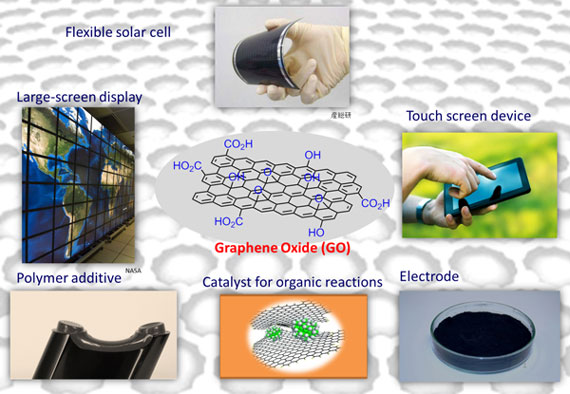| Jun 20, 2013 |
Researchers develop a method for the rapid preparation of graphene oxide
|
|
(Nanowerk News) The most common method for synthesizing GO is the Hummers' method (oxidation with KMnO4 and NaNO3 in concentrated H2SO4), which requires a long reaction time and large amounts of reagents. In their research, Assistant Professor Yuta Nishina and his team found that the microwave irradiation of natural graphite flakes before the oxidation step improved the efficiency of the oxidation process. This facile method provides a greater amount of GO compared with the original Hummers' method. The team expect our rapid synthesis method based on microwave irradiation to make a major contribution to the large-scale production of GO. Patent information: Japanese patent No.5098064
|
 |
| Promising applications of graphene oxide.
|
|
Graphene is a promising support material for Pt nanoparticles, which triggered much interest in metal/graphene composites. In some cases, however, graphene-supported metal species are not preferred, because the interaction between the metal particles and graphene is quite weak due to the graphene itself is being relatively chemically inert due to the strong sp2 and π binding between carbon atoms in the graphene plane. Consequently, the metal nanoparticles are mobile on graphene, which leads to limited applications of metal/graphene composites. It has been proposed that defects or mechanical strain in graphene can significantly increase the chemical reactivity of graphene itself and also enhance the interaction between metal nanoparticles.
|
|
Therefore, GO offers significant advantages for the synthesis of composites with inorganic materials and organic polymers due to its large amounts of oxygen functionality. As an application of our GO, metal nanoparticles were supported on its surface. The team succeeded to synthesize Pt, Pd, Rh, Ir, Cu, etc. nanoparticles on GO via solution processes.
|
|
Controlling the degree of oxidation of GO and the oxidation state of metal species will offer a wide range of applications of metal/GO composites such as electrodes, fuel cell catalysts, and catalysts for chemical synthesis. The team showed that the Pd/GO composite exhibited superior catalytic activity in selective hydrogenation and cross coupling reactions. Japanese patent application No.2012-201088
|

